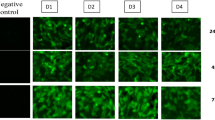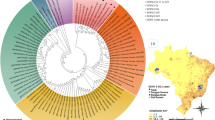Summary.
Dengue infection poses a serious public health problem in most tropical and subtropical areas. No effective antiviral drugs or vaccines are currently available against dengue infection. To explore the feasibility of using capsid-targeted viral inactivation (CTVI) as an antiviral strategy against dengue infection, we constructed a plasmid expressing a fusion protein consisting of staphylococcal nuclease (SN) fused to dengue 2 virus capsid protein (D2C), and investigated its effects on the production of infectious virions when introduced into BHK cells infected with dengue virus. The results indicated that D2C-SN can be expressed and tolerated in this mammalian cell culture. The enzymatically active SN moiety was incorporated into nascent virions during the process of viral assembly. By comparing the effects of incorporated SN and SN*, an enzymatically inactive missense mutant form of wild-type SN, on the infectivity of progeny virions, we clearly demonstrated that nucleolytic activity was the major antiviral mechanism. Expression of D2C-SN fusion protein as a therapeutic agent resulted in a reduction in infectious titers of 12- to 60-fold. Therefore, dengue virus may be particularly vulnerable to a CTVI therapeutic approach.
Similar content being viewed by others
Author information
Authors and Affiliations
Rights and permissions
About this article
Cite this article
Qin, CF., Qin, E., Yu, M. et al. Therapeutic effects of dengue 2 virus capsid protein and staphylococcal nuclease fusion protein on dengue-infected cell cultures. Arch Virol 150, 659–669 (2005). https://doi.org/10.1007/s00705-004-0451-3
Received:
Accepted:
Published:
Issue Date:
DOI: https://doi.org/10.1007/s00705-004-0451-3




